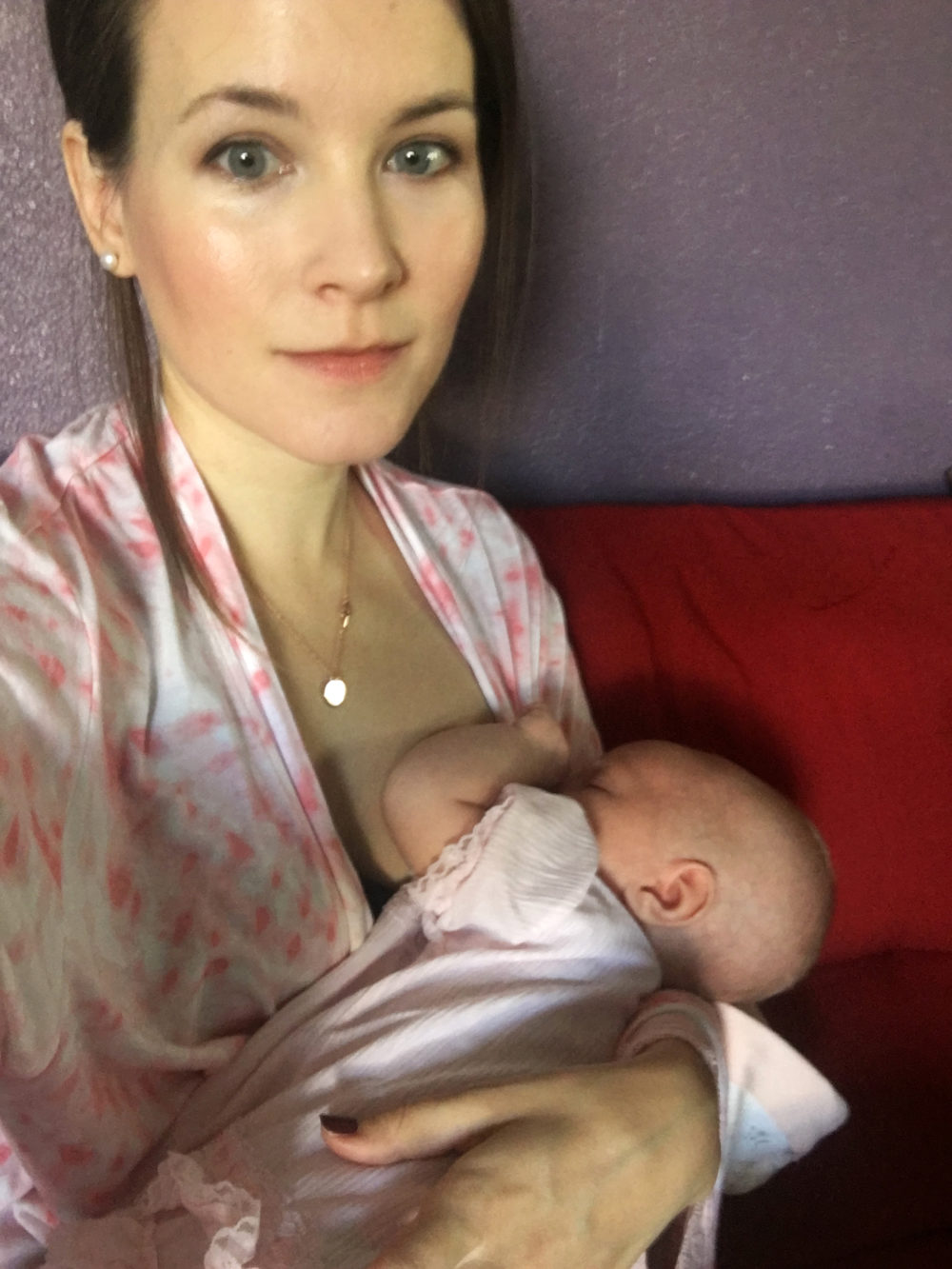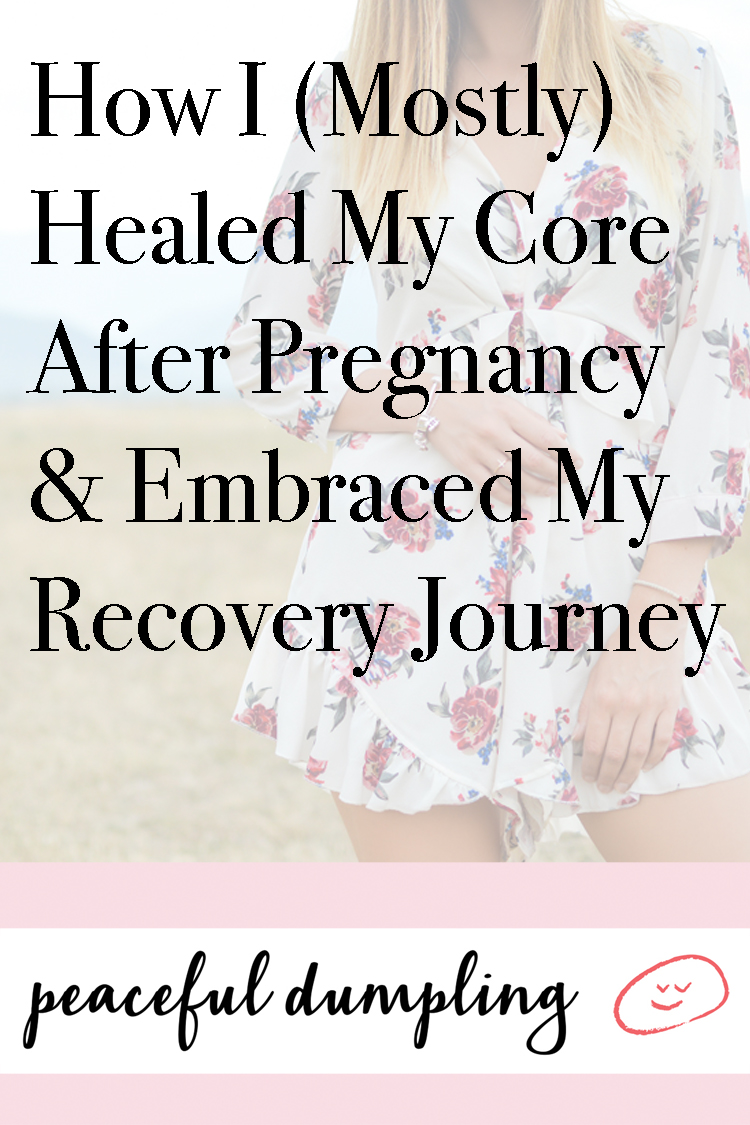 Shortly after I became pregnant, one of the first things my midwife told me was to avoid jerking up to a sitting position from a prone position. I diligently broke my habit of springing up in bed and instead practiced rolling to my side and using my arms to push myself into sitting position.
Shortly after I became pregnant, one of the first things my midwife told me was to avoid jerking up to a sitting position from a prone position. I diligently broke my habit of springing up in bed and instead practiced rolling to my side and using my arms to push myself into sitting position.
This was just one of the many (mini) lifestyle changes I made during the nine months of pregnancy to avoid injuring my core. Diastais recti is a condition that occurs in roughly 60% of pregnancies, by some estimates, and it refers to a separation of the rectus abdominis (the “six pack” muscles we all possess regardless of what our center looks like on the outside.) While there is naturally some separation and stretching of the center to make room for baby, in my case, the condition was diagnosed after the 6-week postpartum mark, which is roughly around the time the uterus returns to its pre-pregnancy size.
I was warned that abdominal separation could set the stage for further complications—hernia, organ prolapse, incontinence, and general weakness. Most online articles addressing the condition also credit it with postpartum stomach bulging, regardless of the amount of weight you lose.
Proposed solutions to the problems range from DIY to more intensive measures, including following certain exercise regimens at home, wearing a corrective girdle or stint (the efficacy of which is hotly contested), seeking physical therapy, and correcting a more serious case with surgery.
It’s enough to really frighten a soon-to-be mom! In an effort to protect my core during pregnancy, I avoided crunches, planks, roughly half of my usual yoga routine, and even certain stretches. Despite all of that, I could feel my core straining as by baby grew (and stretched her limbs inside of me!). I braced my self for the unknown while simultaneously becoming increasingly excited about meeting my baby.
On “Bouncing Back”
For…forever?…and still today, mothers have been encouraged to appear like we never had a baby, to “bounce back,” to have sexy breasts (regardless of breasts’ nutritive function), and fit into our old clothes within a week (at least according to one very stable genius). Indeed, in our current mainstream culture, a “mom body” doesn’t have the same cutesy connotation as the endearing “dad bods” populating listicles and the like).
On the other hand, the tide is turning in some corners—body positive activists are speaking out about embracing post-baby bodies and being real about the struggle to exercise, eat healthy, and be constantly attentive to a little one all while keeping your sanity hat on.
In fact, my pregnancy/baby app is constantly offering me 5 (8? 100?) tips for loving my postpartum body. And for every postpartum shape wear ad, I see even more Instagram posts about embracing the bodily changes that come with delivery (like C-section scars) and pregnancy (from weight gain to melanoma to stretch marks) and praising the hard, hard work our bodies did to create our beautiful children.
I think this is wonderful. The most awareness we bring to what pregnancy actually puts your body through, perhaps the less we will be expected to shed any trace of having brought life into the world and navigate our postpartum appearances more on our own terms.
During my own postpartum journey (which, after 7 months, I’m still on!), I feel warmed by the call for self-love from other mommas. But I want to be honest, too. My own recovery was complicated, leaving me feeling conflicted and frustrated—and not always in celebration of my valiant body.
My labor was long to say the least. I labored for three days, at which point my midwife said my body didn’t know what to so (her words) and transferred me to the hospital, where on day #4, I had a vacuum-assisted delivery, aided me doing crunches (crunch + vacuum = baby, in my case).
I knew my active laboring contributed to diastasic recti. I hated even touching my stomach during the first month. It felt like there was a big hole between my center muscles. I was left feeling like my body was in tatters and wondering why my labor was so haywire. I was annoyed by the sign in the midwife’s office reading, “My body isn’t broken.”
I felt overwhelmed and impatient when it came to healing my injured core. Admittedly, I also wondered if my body would return to a new version of its old self. I think it’s natural to want to recover in a certain way if you liked the way your body functioned (and looked) before. For me, “bouncing back,” thought that’s hardly an accurate phrase, meant regaining my functionality, core stability, and the sense of feeling good in my body.
Working to return to your level of strength and tone isn’t necessarily mutually exclusive of appreciating your body in its current state—even if your relationship with your body is complicated and fraught.
The important thing is to not let those desires turn into something unhealthy, of course. Approaching the journey with gentleness and patience (easier said than done!) and arming yourself with knowledge on healing is the best way to go—at least it was for me. The following is a breakdown of my healing processes.
How I (Mostly) Healed
Walking
Because of the multiple tears I experienced during delivery, I had difficulty walking during the first few weeks. So my goal was just walking a few blocks a day. By one month, I was walking with nearly no pain. By two months, I could walk a mile or so. At seven months, I still walk everyday, sometimes a mile or three (but I’m just estimating—I walk as long as it feels good!). Also, my baby enjoys being outdoors, so that’s a plus!
It sounds so mundane (and unrelated to core healing), but walking is paramount. Getting into the sunlight and boosting my circulation was like drinking in healing (and better sleep and mood!). Walking daily helped me restore faith in my body.
Retraining my Lower Abs (TA)
After about six weeks, I confirmed that I had a 2 finger-wide gap after the initial healing that took place after delivery. (Diastasis recti gaps are measured in inches-wide or fingers-wide gap; the connective tissue is also assessed to determine how deep the separation goes. My connective tissue had remained fairly tight, so my gap was more of a width issue than a depth issue.)
All in all, this wasn’t terrible. I could tell that my core needed work to become the stable powerhouse it once was. I also needed to regain proprioception—my sense of where my muscles were was all off.
There are several, postpartum safe exercises you can do to reconnect with your core (and possibly? shorted the gap). My first workouts lasted about five minutes and weren’t the kind that worked up a sweat.
My gap closed some (maybe half an inch?), but the biggest thing was how these exercises gave me the foundation and confidence to branch out and do other, non-postpartum-specific workouts including barre, Pilates, and HIIT. (But even during those, I skipped crunches just in case.)
When I Felt Healed
Around five months postpartum, I noticed a shift. My body felt like it had made a near full recovery in terms of strength, balance, proprioception, agility, and stability. I also looked like the person I had identified with for so long prior to becoming pregnant. While that’s not necessarily an indication of healing, it was nice to feel like my old self.
Still, a slight gap remained, and I wondered if it would ever completely close, and if not, would I really be healed?
Yes, actually. At least according to emerging definitions of healed diastasic recti.
New research suggests that physiotherapy (like the exercises I did) may not actually make a difference in actually bringing the gap together even though they may be good to do for increasing strength. The latest theory is if the gap heals any, it may have done so on its own.
“‘You can do anything you want’ is the first thing we tell them. If you look at the studies, the exercises that are prescribed to treat it, or attempt to treat it, are completely opposite of each other. Some focus on stretching, others focus on pulling it all together, and none of them work,” says Dr. Elwin Mommers, who published a meta-analysis of studies on diastasis recti healing.
For a while the assumption has been that if your connective tissue is stretched, it’s weaker, but Mommers is questioning that thinking. “If it were weak, then [people with abdominal separation] would be more prone to develop hernias, and there is absolutely no proof that abdominal separation eventually results in hernia,” he said.
Moreover, Kari Bø, a professor at the Norwegian School of Sports Sciences, explains, ”It may be that for many women, a tiny gap may not influence function.”
Her thinking is echoed by Wendy Powell, founder of the MuTu system, one of the leading postpartum rehabilitating programs: “To me, success looks like function, a body that works, that doesn’t hurt, that doesn’t leak, bulge, protrude or feel pressure.”
Where this Leaves Me
I’ve learned that the healing process can be really beautiful even if it’s accompanied by pain and uncertainty. I’ve also learned that it’s highly individualized. As research demonstrates, there’s no one correct method—not to mention each pregnancy and postpartum period is different.
I realized that more is not more when it comes to consuming information. While some advice from professionals, fitness gurus, and even other mothers can be helpful, so can taking an “information fast” (a phrase coined by Anita Moorjani) to let the info settle while giving yourself space to determine what feels right for you.
Moving forward, I’m continuing to tune into what feels best for my body on a given day. Some days that’s a nice workout on the mat—other times it’s a long, slow walk with my baby–or just a cuddle on the couch.

__
Related: 7 Fun, Crunches-free Core Exercises
How A Trip To Costa Rica Did More For Healing My Gut Than Weeks Of Eating Ayurveda
Mindfully Healing an Injury with Ashtanga Yoga
Get more like this—Subscribe to our daily inspirational newsletter for exclusive content!

__
Photo: Pete Bellis via Unsplash, Mary Hood Luttrell




